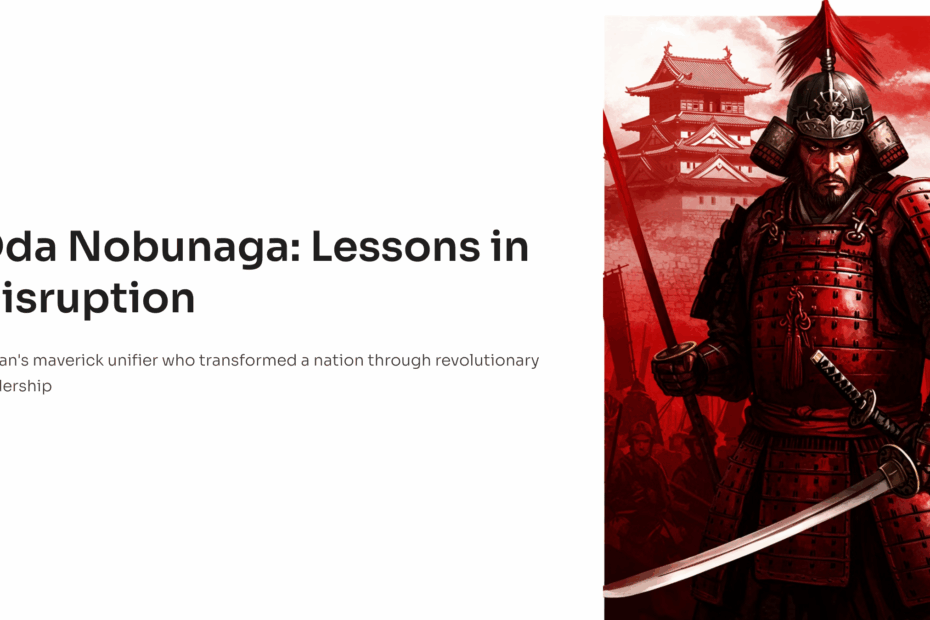Oda Nobunaga: The Maverick Unifier and His Legacy of Innovation – Lessons for Today’s Disruptors
Introduction
John: Welcome, everyone, to our exploration of one of Japan’s most fascinating and transformative historical figures: Oda Nobunaga (織田信長). He was a pivotal daimyō (feudal lord) during the tumultuous Sengoku period (戦国時代 – Warring States period, roughly 1467-1615), a time of near-constant civil war and social upheaval. Nobunaga is renowned not just for his military prowess, but for his revolutionary thinking and his ambition to unify a fractured Japan.
Lila: Hi John! I’m so excited to dive into Nobunaga. He’s almost like a rockstar figure in Japanese history, isn’t he? And I hear so much about how his methods were incredibly innovative, almost like a 16th-century startup founder shaking up an entire industry – in his case, the “industry” of ruling Japan! It sounds like he was the original “破天荒CEO” (hatenkou CEO – unconventional CEO) that many modern leaders try to emulate.
John: That’s an excellent modern parallel, Lila. His approach was certainly unconventional for his time, and his impact on Japan was profound. He laid the critical groundwork for the nation’s reunification after centuries of division. We’ll be looking at his life, his radical strategies, and how his legacy continues to inspire discussions about leadership and innovation, especially for those interested in “既成概念を破壊するイノベーション経営術” (kisei gainen o hakaisuru innovation keieijutsu – innovation management that destroys preconceived notions).
Early Life & Family Background
John: Oda Nobunaga was born in 1534, likely at Nagoya Castle or Shobata Castle, in Owari Province (尾張国 – present-day western Aichi Prefecture). He was the second son of Oda Nobuhide, a deputy military governor with significant landholdings in Owari. (Source: Lamers, J. “Japonius Tyrannus: The Japanese Warlord Oda Nobunaga Reconsidered”). The Oda clan itself was not one of the most powerful or ancient families at the national level, but Nobuhide was an ambitious and capable warrior who expanded their influence locally.
Lila: So, he wasn’t born into the top tier of nobility, but his family was definitely on the rise? What was his childhood like in such a chaotic period? I’ve heard he had a rather notorious nickname as a young man.
John: Indeed. In his youth, Nobunaga was known for his eccentric behavior. He often dressed unconventionally, associated freely with commoners, and flouted many of the rigid social norms expected of a young samurai of his station. This earned him the moniker “Owari no Ōutsuke” (尾張の大うつけ – The Great Fool of Owari). (Source: Berry, M. E. “Hideyoshi”). There are accounts of him, for instance, attending his father’s funeral and sacrilegiously throwing incense at the altar. This behavior deeply concerned many of the Oda retainers.
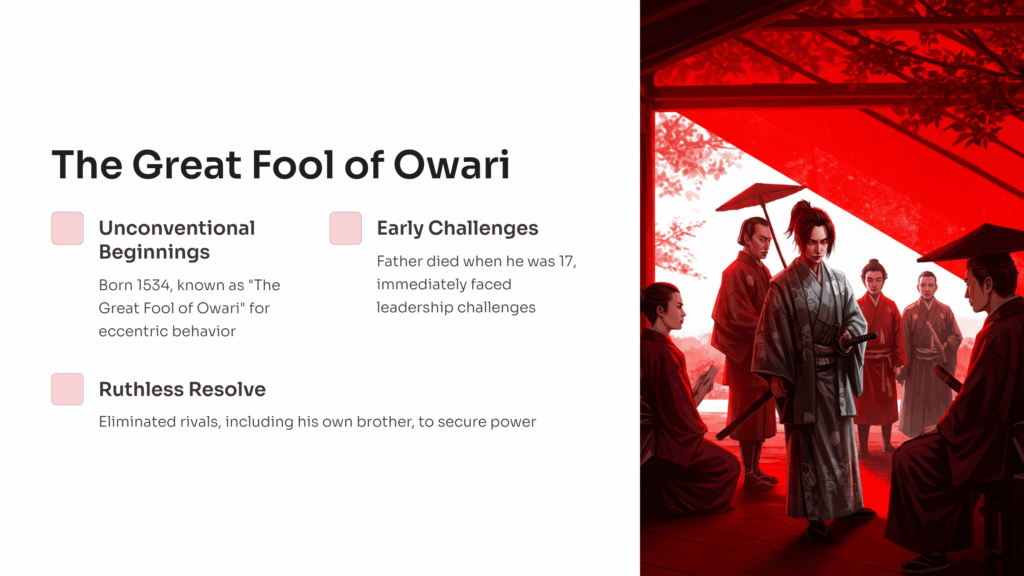
Lila: “The Fool of Owari”! That’s quite a label. Do historians think this was a deliberate act to make rivals underestimate him, or was he genuinely just a non-conformist? It sounds like he was already practicing “既成概念の破壊” (kisei gainen no hakai – destruction of preconceived notions) from a young age!
John: That’s a long-standing debate. Some historians suggest it might have been a calculated ploy to appear non-threatening while he consolidated his own power base and observed his rivals. Others believe it was a genuine reflection of his impatient and unconventional personality. Regardless of the intent, this early period certainly shaped him. His father, Nobuhide, died in 1551, and Nobunaga, then only about 17, faced immediate challenges to his leadership from within his own clan and from neighboring warlords. This crucible of internal strife and external threats likely forged his decisive and often ruthless character.
Lila: So, he had to fight for his position right from the start. That must have honed his “短期決断力” (tanki ketsudanryoku – short-term decision-making power) that he became famous for.
John: Precisely. He couldn’t afford indecision. He systematically eliminated rivals within the Oda clan, including his own brother, Oda Nobuyuki, whom he had executed in 1557 after a failed rebellion. This demonstrated his resolve and ruthlessness early on.
Key Events & Turning Points
John: Nobunaga’s path to power is marked by several critical events that showcased his military genius, audacious strategies, and transformative vision.
Lila: I’m ready for the highlights! Where do we start?
John:
- The Battle of Okehazama (桶狭間の戦い – 1560): This is arguably his most legendary victory and a defining moment. Imagawa Yoshimoto, a powerful daimyō from Suruga Province, invaded Owari with an army estimated at 25,000 to 40,000 men. Nobunaga, with a force of perhaps only 2,000 to 3,000, launched a surprise attack during a thunderstorm. (Source: Turnbull, S. “The Samurai Sourcebook”). Yoshimoto was killed, and his army routed. This victory catapulted Nobunaga onto the national stage.
- Unification of Owari Province: Following Okehazama, Nobunaga swiftly consolidated his control over Owari, eliminating remaining opposition and securing his home base.
- Alliance with Matsudaira Motoyasu (later Tokugawa Ieyasu): In 1562, Nobunaga formed a crucial alliance with Matsudaira Motoyasu of neighboring Mikawa Province. This alliance would last for two decades and was instrumental for both their ambitions.
- Conquest of Mino Province (1567): After years of struggle, Nobunaga conquered Mino Province from the Saitō clan. He moved his primary castle to Inabayama Castle, renaming it Gifu Castle (岐阜城), and it was around this time he began using the seal “Tenka Fubu” (天下布武 – roughly “All the world under one sword” or “Rule the realm by military force”).
- March to Kyoto (1568): Responding to an appeal from Ashikaga Yoshiaki, who sought to become Shogun, Nobunaga marched his army into Kyoto, the imperial capital. He installed Yoshiaki as the 15th Ashikaga Shogun, but in reality, Yoshiaki became a puppet ruler, with Nobunaga holding the true power.
- Siege of Mount Hiei (比叡山焼き討ち – 1571): The warrior monks of the Enryaku-ji temple complex on Mount Hiei had allied with Nobunaga’s enemies. In a move that shocked many and cemented his reputation for ruthlessness, Nobunaga ordered his forces to surround the mountain and destroy the entire complex, killing thousands of monks, women, and children. (Source: Sansom, G. “A History of Japan, 1334-1615”).
- Battle of Nagashino (長篠の戦い – 1575): This was a landmark battle in military history. Facing the formidable cavalry of the Takeda clan, led by Takeda Katsuyori, Nobunaga and Tokugawa Ieyasu employed an innovative tactic: rows of arquebusiers (matchlock gunners) firing in volleys from behind wooden palisades. This decimated the Takeda cavalry charges and demonstrated the rising importance of firearms in Japanese warfare, a clear example of “新技術導入” (shin gijutsu dounyuu – introduction of new technology).
- Construction of Azuchi Castle (安土城 – completed around 1579): Nobunaga built a magnificent seven-story castle on the shores of Lake Biwa. Azuchi Castle was not just a military fortress but a symbol of his power and vision, lavishly decorated and designed to impress and intimidate. Its central keep, or tenshu, was unlike anything seen before.
- The Honnō-ji Incident (本能寺の変 – 1582): At the height of his power, while he was on the verge of unifying most of Japan, Nobunaga was betrayed by one of his most trusted generals, Akechi Mitsuhide. Surrounded in the Honnō-ji temple in Kyoto with only a small contingent of guards, Nobunaga was forced to commit seppuku (ritual suicide). His body was never definitively found (legend says the temple burned so intensely).
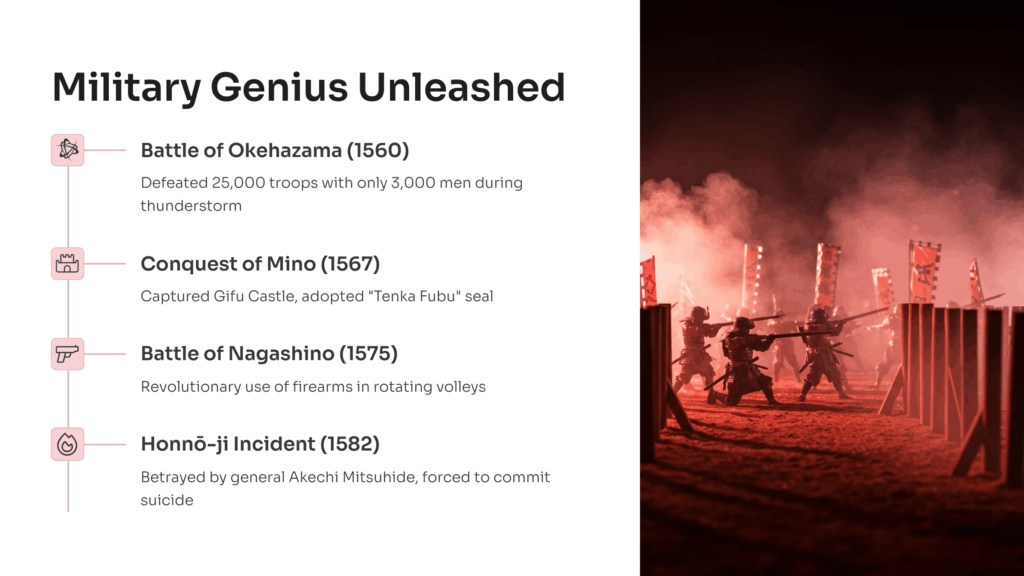
Lila: Wow, what a rollercoaster! Okehazama sounds like a David vs. Goliath story, but with brilliant strategy. And Nagashino – using firearms like that must have been revolutionary. It’s like he was constantly disrupting the “rules” of warfare. But the Honnō-ji Incident… after all that, to be betrayed by one of his own. That’s tragic.
John: It is one of history’s great “what ifs.” Had he lived, Japan’s unification might have taken a different course, or happened even sooner. Each of these events reveals different facets of his character: his audacity at Okehazama, his strategic foresight in alliances and Gifu, his ruthlessness at Mount Hiei, his embrace of new technology at Nagashino, and his grand vision with Azuchi Castle.
Leadership Style / Philosophies / Personality Traits
John: Nobunaga’s leadership style was a complex mix of traits, many of which were radical for his era and resonate with modern concepts of “変革リーダー” (henkaku leader – transformational leader).
Lila: This is the part I’m really keen on, especially for anyone interested in leadership lessons. What made him tick?
John:
- Visionary and Ambitious: His overarching goal, famously encapsulated in his “Tenka Fubu” seal, was the unification of Japan under his rule. This was a grand vision in a land fractured by warring factions for over a century.
- Decisive and Swift: Nobunaga was known for his “短期決断力CEO” (tanki ketsudanryoku CEO – CEO with short-term decision-making power) quality. He made decisions quickly and acted upon them with speed, often catching his opponents off guard.
- Ruthless and Pragmatic: He was not afraid to use brutal force to achieve his objectives, as seen at Mount Hiei or against the Ikkō-ikki (warrior monk and peasant confederations). He valued results over tradition or sentimentality. If an old way wasn’t working, he’d discard it. This is pure “既成概念の破壊” (destruction of preconceived notions).
- Meritocracy (to a degree): Unusually for his time, Nobunaga often promoted individuals based on talent and loyalty rather than solely on noble birth or lineage. A prime example is Toyotomi Hideyoshi, who rose from peasant origins to become one of Nobunaga’s top generals, and eventually his successor in unifying Japan. (Source: Elisonas, J. in “Cambridge History of Japan, Vol. 4”).
- Innovative and Open to New Ideas: His adoption and effective use of firearms at Nagashino is the most famous example. He also implemented economic policies like Rakuichi Rakuza (楽市楽座 – free markets and open guilds), which aimed to break down monopolistic trade barriers and stimulate commerce in castle towns. This fostered “尾張イノベーション” (Owari innovation – innovation that started in Owari and spread).
- Curiosity about the Outside World: Nobunaga showed considerable interest in Western culture, technology, and ideas brought by Jesuit missionaries, such as Luís Fróis, whose writings provide valuable contemporary accounts of Nobunaga. He collected Western artifacts, wore Western-style clothing at times, and engaged in discussions about religion and global affairs.
- Intense and Demanding: Accounts suggest he had a fiery temper and high expectations of his subordinates. Failure could be met with severe punishment. Yet, he could also be generous to those who served him well.
Lila: That’s quite a profile! The meritocracy aspect is particularly interesting. It sounds like a modern tech company valuing talent over pedigree. And his Rakuichi Rakuza policy – breaking down old monopolies to encourage new business – that’s a classic disruptor move! Was he always so intense, though? Did he have a softer side?
John: There are glimpses of other facets. He was a patron of the arts, including the tea ceremony and Noh theatre. He was known to be fond of the Noh play *Atsumori*. Some accounts suggest he could be personable and even charming when he chose to be. However, the prevailing image, supported by many of his actions, is one of an immensely driven, often severe, and highly focused leader. He was a “変革責任者” (henkaku sekininsha – person responsible for change) in the truest sense.
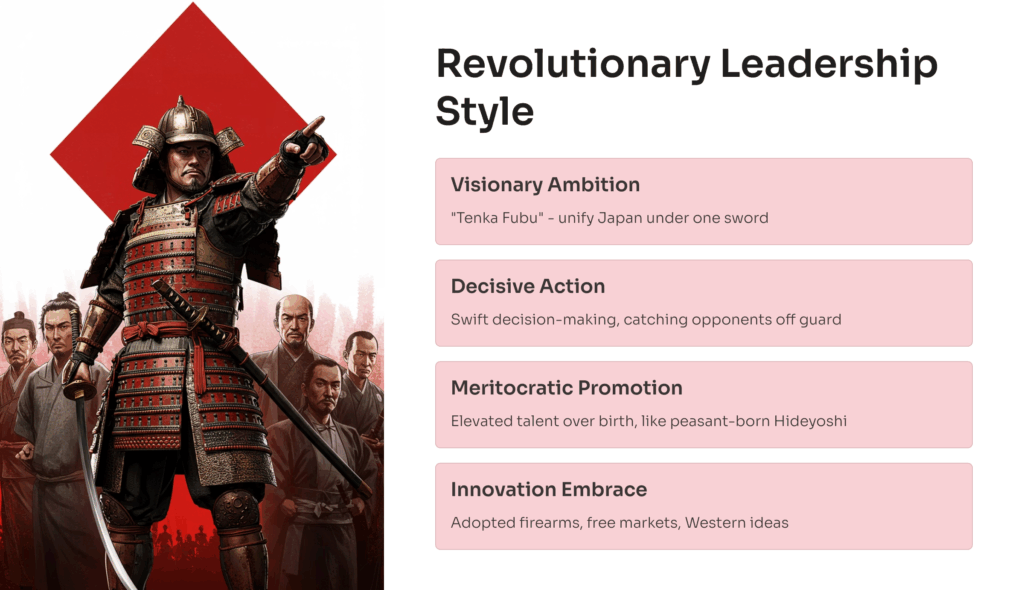
Famous Quotes or Decisions
John: Several of Nobunaga’s decisions and attributed sayings have become legendary, illustrating his mindset.
Lila: Let’s hear them! Quotes can often give you a real insight into someone’s core beliefs.
John:
- “Tenka Fubu” (天下布武): As mentioned, this phrase appeared on his official seal from around 1567. While its exact nuance is debated (“To bring the realm under military rule,” “To spread military governance throughout the land,” or even “The world under one sword”), its intent was clear: a unified Japan under his authority. This was a bold declaration of his ultimate ambition.
- The Decision to Employ Massed Arquebuses at Nagashino: While firearms were not new to Japan (introduced by the Portuguese in 1543), Nobunaga’s strategic deployment of them in rotating volleys was revolutionary. It required significant logistical effort for gunpowder and ammunition, training, and a willingness to fundamentally change battlefield tactics, moving away from a primary reliance on samurai cavalry and archery. This was a conscious choice for “新技術導入” (introduction of new technology).
- Implementation of Rakuichi Rakuza Policies: These policies abolished traditional market monopolies (za) and guild restrictions in his castle towns, notably Gifu and later Azuchi. This encouraged free trade, attracted merchants and artisans, and boosted the local economy, which in turn supported his military campaigns. (Source: Wakita, O. “The Commercial and Urban Policies of Oda Nobunaga and Toyotomi Hideyoshi”).
- The Destruction of Enryaku-ji on Mount Hiei: This was a ruthless but calculated decision. The temple complex was a major military and political power that had repeatedly defied him and sheltered his enemies. Its destruction sent a clear message that no traditional authority was beyond his reach if it opposed his unification efforts.
- His (legendary) recital of a passage from the Noh play *Atsumori* before the Battle of Okehazama: (Legend says) that before sallying forth for the seemingly impossible battle, Nobunaga performed a part of this play, which includes the lines: 「人間五十年、下天のうちをくらぶれば、夢幻の如くなり。一度生を享け、滅せぬもののあるべきか。」 (“A man’s life of 50 years under the sky is nothing compared to the age of Geten (the lowest heaven). It is but a dream, an illusion. Is there anyone who, once born, is not to die?”). This reflected a certain samurai fatalism but also a resolve to act decisively, regardless of the odds. (The association of this performance with Okehazama is popular but its historicity at that specific moment is debated).
- Calling himself “Dairokuten Maō” (第六天魔王 – Demon King of the Sixth Heaven): In a letter to Takeda Shingen, who had declared himself the “Protector of Buddhism,” Nobunaga (disputedly) signed off with this title. The Sixth Heaven in some Buddhist cosmology is a realm of desire ruled by a demon king who tries to prevent people from attaining enlightenment. It was a deliberately provocative and defiant title, showing his contempt for traditional Buddhist powers that opposed him.
Lila: “Tenka Fubu” is so direct and powerful. And the *Atsumori* quote, if true for that moment, is incredibly dramatic – like embracing the fleeting nature of life before a huge gamble. The “Demon King” title is a bit shocking! Was he really trying to be seen as evil, or was it more of a power play, a psychological tactic?
John: It was likely a combination. It was certainly a power play, a defiant stance against established religious authorities who were also significant political and military forces. It also contributed to his fearsome reputation, which could be a powerful tool in itself. Whether he truly saw himself in those terms, or simply used it for effect, is open to interpretation. But it demonstrates his willingness to use any means, including psychological warfare, to achieve his goals.
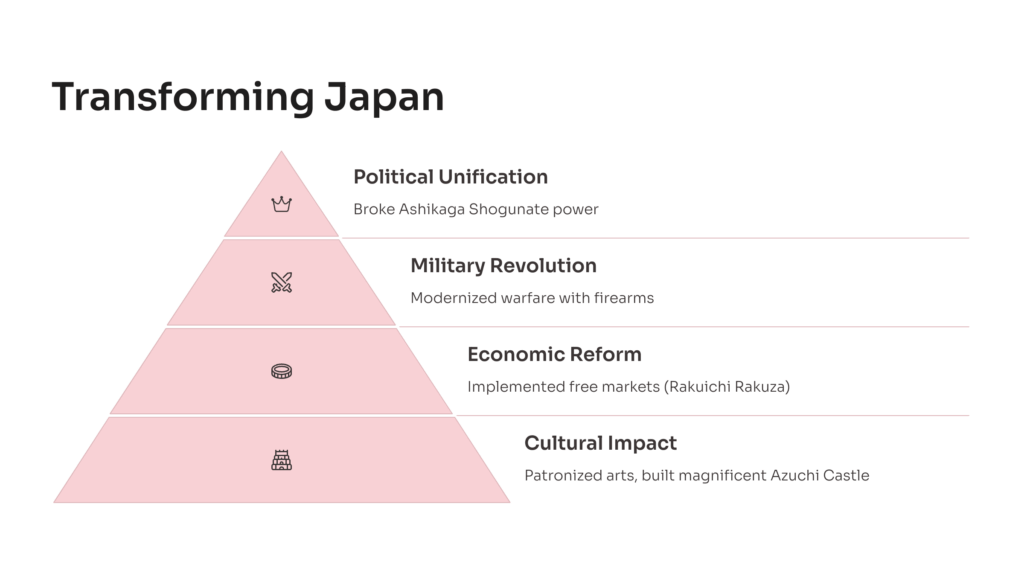
Influence on History (Military, Political, Cultural, etc.)
John: Nobunaga’s relatively short period of dominance, roughly two decades, had a disproportionately massive and lasting influence on Japanese history.
Lila: It sounds like he was a true catalyst for change. How did he reshape Japan?
John:
- Military Transformation:
- He revolutionized warfare through the large-scale, systematic use of firearms, as demonstrated at Nagashino. This forced other daimyō to adapt or be overwhelmed.
- He developed more sophisticated siege tactics and castle designs (e.g., Azuchi Castle, which was also a political statement).
- His armies were increasingly professionalized and larger than many seen before, relying less on seasonal peasant levies and more on a standing core of soldiers.
- Political Unification and Centralization:
- He decisively broke the power of the Ashikaga Shogunate, which had become a hollow institution, by eventually exiling Shogun Ashikaga Yoshiaki in 1573.
- He systematically weakened the power of major Buddhist temple complexes like Enryaku-ji and the Ikkō-ikki, which had acted as independent political and military entities for centuries.
- By conquering or subduing roughly a third of Japan’s provinces, he laid the essential groundwork for the complete unification achieved by his successors, Toyotomi Hideyoshi and Tokugawa Ieyasu. Without Nobunaga’s initial, brutal consolidation, their tasks would have been immeasurably harder.
- Economic Reforms:
- His Rakuichi Rakuza policies stimulated commerce, broke down internal trade barriers, and led to the growth of vibrant castle towns.
- He initiated land surveys (kenchi) to more accurately assess agricultural productivity and tax revenues, a practice expanded by Hideyoshi.
- Standardization of weights and measures, and road construction (though more developed under Hideyoshi) began to facilitate trade and communication.
- Cultural Impact:
- Azuchi Castle became a symbol of a new era of power and aesthetics, influencing subsequent castle architecture. It was lavishly decorated by prominent artists like Kanō Eitoku, fostering the Azuchi-Momoyama period’s distinctive artistic style.
- He was a patron of the tea ceremony, and his association with masters like Sen no Rikyū helped elevate its status.
- His interest in Western goods and culture, though limited in direct long-term impact due to later isolationist policies, signaled an openness that was unique among the major warlords of his time.
Lila: It’s incredible how multifaceted his influence was – military, political, economic, and even cultural. He really did shake the foundations of medieval Japan and set the stage for a completely new era. It feels like he was the ultimate “変革責任者” (henkaku sekininsha – person responsible for change).
John: Absolutely. He was a destroyer of the old order, but also a builder of the new. Many of the systems and policies he initiated were refined and expanded by Hideyoshi and Ieyasu, leading directly to the Tokugawa Shogunate and over 250 years of relative peace and stability. His vision of a unified Japan, “Tenka Fubu,” became a reality shortly after his death.
Controversies & Historical Debates
John: Nobunaga is, without a doubt, one of the most controversial figures in Japanese history. His methods and personality continue to spark debate among historians and the public.
Lila: Given his reputation for ruthlessness and that “Demon King” moniker, I can imagine! What are the main points of contention?
John:
- His Ruthlessness and Brutality: The massacre at Mount Hiei, the relentless campaigns against the Ikkō-ikki (which involved the slaughter of tens of thousands at sieges like Nagashima), and the harsh treatment of some defeated enemies are often cited. Was this level of brutality necessary for unification in a brutal age, or did it represent an exceptional cruelty? Historians like Asao Naohiro have explored the “violence” inherent in the unification process.
- His Personality – Arrogance and Impatience: Contemporary accounts, including those by Jesuits like Luís Fróis, often describe him as arrogant, quick-tempered, and intolerant of incompetence or opposition. How much did these traits contribute to his success, and how much to his eventual downfall (by alienating key retainers like Akechi Mitsuhide)?
- The “Demon King of the Sixth Heaven” (第六天魔王 – Dairokuten Maō) Image: How literally should we take this? Was it a calculated persona, a genuine reflection of his perceived opposition to Buddhist powers, or a label amplified by his enemies? Some scholars argue it was a strategic tool to project an image of fearsome, almost supernatural power.
- The Motives for Akechi Mitsuhide’s Betrayal: This is one of the great enduring mysteries. Theories abound: a personal grudge (Nobunaga had allegedly insulted or mistreated Mitsuhide publicly – though the historicity of specific incidents is debated), ambition on Mitsuhide’s part, fear of Nobunaga’s increasingly autocratic tendencies, pressure from other powers (like the Imperial Court or even Christian missionaries – though these are highly speculative), or a desire to protect traditional institutions that Nobunaga was dismantling. (Source: Kuwata, T. “Akechi Mitsuhide”). No single theory has universal acceptance, and primary sources are frustratingly vague on Mitsuhide’s precise motives.
- His Religious Policies: While he brutally suppressed militant Buddhist sects that opposed him, he was generally tolerant of Christianity, at least initially, seeing it perhaps as a useful counterweight to Buddhist power and a conduit for Western trade and technology. Was this genuine tolerance or political expediency? His exact religious beliefs remain unclear.
Lila: The Akechi Mitsuhide betrayal is like a historical whodunit! So many potential motives. And it really highlights how complex Nobunaga was. He could be forward-thinking and tolerant in some ways, like with Christianity or new economic ideas, but utterly brutal in others. It’s hard to fit him into a simple “good guy” or “bad guy” box.
John: Precisely. He defies easy categorization. He was a man of his violent times, but also a man who sought to end those violent times through radical, often brutal, means. The debates surrounding him reflect the profound impact he had and the difficult questions his actions raise about power, change, and the price of unification.
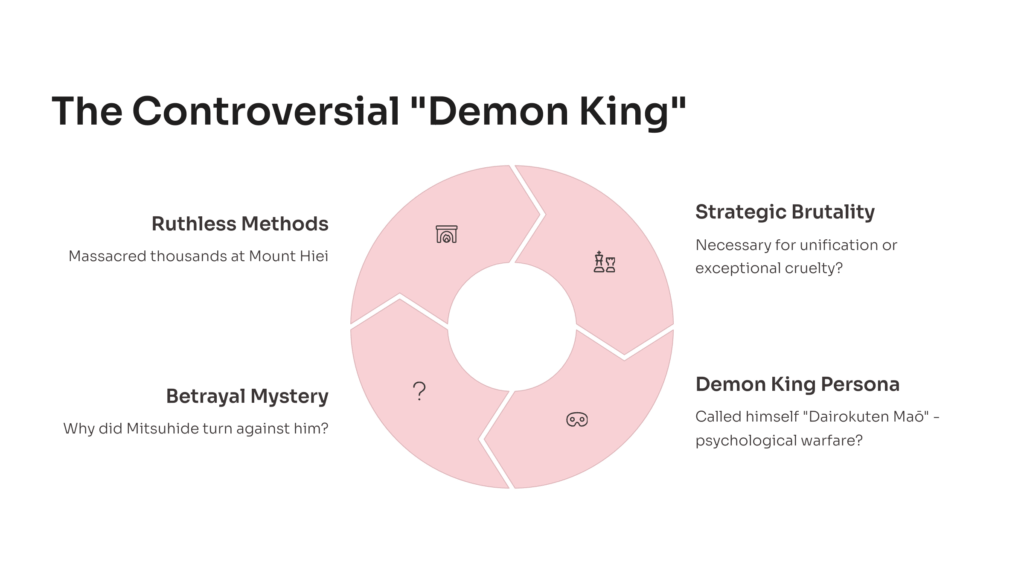
Modern Lessons We Can Learn from Them
John: Despite being a 16th-century warlord, Oda Nobunaga’s career offers some surprisingly relevant lessons, especially for those in leadership roles or anyone trying to drive significant change. This is why there’s such enduring interest in “織田信長に学ぶ!既成概念を破壊するイノベーション経営術” (Oda Nobunaga ni manabu! Kisei gainen o hakaisuru innovation keieijutsu – Learn from Oda Nobunaga! Innovation management that destroys preconceived notions).
Lila: This is the part that really connects with the modern world! What can today’s CEOs, startup founders, or “変革責任者” (henkaku sekininsha – change leaders) take away from his story?
John:
- Embrace Innovation and New Technologies: Nobunaga wasn’t afraid to adopt new tools and methods if they gave him an edge. His use of firearms at Nagashino is a prime example. The lesson is to be open to “新技術導入” (introduction of new technology) and to think strategically about how it can transform your field.
- Challenge the Status Quo (Disrupt Preconceived Notions): He consistently defied traditional ways of thinking, whether in military tactics, economic policy (Rakuichi Rakuza), or social hierarchy (merit-based promotions). This willingness for “既成概念の破壊” (destruction of preconceived notions) is key for any innovator.
- Have a Clear Vision and Act Decisively: Nobunaga’s “Tenka Fubu” was a clear, ambitious vision. He pursued it with relentless focus and “短期決断力” (short-term decision-making power). Leaders need a compelling vision and the courage to act on it, even when facing uncertainty.
- Value Talent and Merit: His promotion of Hideyoshi shows the power of recognizing and elevating talent, regardless of background. Building a strong team based on ability is crucial.
- Understand Your Environment and Adapt: Nobunaga was astute in understanding the political landscape, forming alliances, and exploiting his enemies’ weaknesses. Leaders must be aware of their competitive environment and be flexible enough to adapt their strategies.
- Calculated Risk-Taking: The Battle of Okehazama was a huge risk, but it was based on intelligence and a bold plan. Innovation often requires taking calculated risks rather than reckless gambles.
- Effective Communication (even if unconventional): While his methods could be harsh, his actions and declarations (like “Tenka Fubu” or even the “Demon King” moniker) sent clear messages about his intent and power. Leaders need to communicate their vision and resolve effectively.
- Beware of Alienating Key People: While the exact cause of Akechi Mitsuhide’s betrayal is unknown, one lesson often drawn is the danger of a leader becoming too autocratic or losing the trust of crucial subordinates. Maintaining relationships and understanding the motivations of your team is vital.
Lila: Those are fantastic points, John. It’s amazing how these themes – “革新的思考” (kakushinteki shikou – innovative thinking), challenging norms, decisive leadership – are just as relevant for a “スタートアップ創業者” (startup founder) today as they were for Nobunaga trying to unify a country. He was a true “変革リーダー” (henkaku leader – transformational leader).
John: Indeed. His story serves as a powerful case study in transformational leadership, albeit one with complex moral dimensions. The core principles of vision, innovation, and decisiveness, however, remain timeless.

Fun Facts / Lesser-known Stories
John: Beyond the major battles and political maneuvers, there are some interesting anecdotes and lesser-known aspects of Nobunaga’s life that add more color to his personality.
Lila: Oh, I love these! They help make such a larger-than-life figure a bit more relatable, or at least more multifaceted.
John:
- Interest in Western Items: Nobunaga was quite taken with items brought by Portuguese traders and Jesuit missionaries. He is said to have worn Western clothing, including velvet cloaks and hats, enjoyed red wine (a novelty in Japan then), and collected things like globes and maps. (Source: Fróis, L. “Historia de Japam”).
- Promotion of Sumo: Nobunaga was a great fan and patron of sumo wrestling. In 1578, he organized a massive sumo tournament at Azuchi Castle, gathering wrestlers from across the provinces he controlled. This event is considered significant in the history and development of professional sumo.
- Fondness for the Noh Play *Atsumori*: As mentioned, he was reportedly fond of this play, which deals with themes of the impermanence of life and the fate of a young warrior. His (legendary) performance of it before Okehazama is a famous tale.
- Yasuke, the African Retainer: Nobunaga had an African man in his service, known as Yasuke. Yasuke arrived in Japan with Jesuit missionaries in 1579 and caught Nobunaga’s attention. Nobunaga was fascinated by his skin color (initially thinking it was ink) and his strength. Yasuke was granted the status of a retainer, given a residence, and even a short sword, indicating a degree of samurai-like standing. (Source: Fujita, M. “African Samurai: The True Story of Yasuke, a Legendary Black Warrior in Feudal Japan”).
- Personal Service to Guests (sometimes): Despite his immense power, there are accounts of Nobunaga sometimes personally serving food or tea to important guests, a gesture that was highly unusual for a powerful daimyō and could be interpreted as either a sign of respect or a calculated display of his unconventional style.
- His Nickname “The Fool of Owari” – Practical Jokes?: Some tales from his youth, contributing to his “Fool of Owari” image, include (legend says) rather boisterous and undignified behavior, like tying gourds to his waist and dancing in the streets, or engaging in mock battles with other youths.
Lila: Yasuke’s story is incredible! An African samurai in 16th-century Japan – that’s a movie waiting to happen, and in fact, it is becoming more widely known. And picturing Nobunaga, the fearsome warlord, being interested in sumo or personally serving guests… it certainly adds layers to the “Demon King” image.
John: It does. These details remind us that historical figures, even those known for grand and sometimes terrible deeds, were complex individuals with varied interests and behaviors. It makes the study of “尾張イノベーション” (Owari innovation) not just about policies but about the person driving them.

Recommended Books / Films / Museums / Historic Sites
John: For those interested in delving deeper into the life and times of Oda Nobunaga, there are many excellent resources available.
Lila: Perfect! A reading and travel list for our audience eager to learn more about this “破天荒CEO” (unconventional CEO) of the Sengoku period.
John:
- Books:
- For an academic yet readable biography in English, Jeroen Lamers’ “Japonius Tyrannus: The Japanese Warlord Oda Nobunaga Reconsidered” is excellent.
- Mary Elizabeth Berry’s “Hideyoshi” also contains significant material on Nobunaga, as their careers were intertwined.
- George Sansom’s “A History of Japan, 1334-1615” provides essential background on the period.
- Stephen Turnbull has written extensively on samurai warfare, and his books like “The Samurai Sourcebook” and “Nagashino 1575: Slaughter at the Barricades” offer great military context.
- For primary source insights, “They Came to Japan: An Anthology of European Reports on Japan, 1543-1640” edited by Michael Cooper, includes excerpts from Luís Fróis.
- Films and Television Series (Taiga Dramas):
- Akira Kurosawa’s film *Kagemusha* (1980) features Nobunaga as a character during the Takeda conflicts.
- Numerous Japanese NHK Taiga Dramas (year-long historical series) have focused on or prominently featured Nobunaga. Some notable ones include *Nobunaga: King of Zipangu* (1992), *Hideyoshi* (1996), *Toshiie to Matsu* (2002), *Kirin ga Kuru* (2020 – focuses on Akechi Mitsuhide but Nobunaga is central). Many of these offer dramatic, if sometimes fictionalized, portrayals.
- Museums:
- Gifu City Museum of History (岐阜市歴史博物館): Located in Gifu Park, near the site of Gifu Castle, it has excellent exhibits on Nobunaga’s time in Gifu.
- Azuchi Castle Nobunaga Museum (安土城郭資料館 – Azuchi Castle Archaeology Museum & Nobunaga no Yakata): Near the ruins of Azuchi Castle in Shiga Prefecture. One museum has a replica of the upper floors of Azuchi Castle’s keep.
- Kiyosu Castle (清洲城): A reconstruction of the castle that was Nobunaga’s base for many years, including during the Battle of Okehazama.
- Historic Sites:
- Ruins of Azuchi Castle (安土城跡): While only the stone foundations remain, visiting the site gives a sense of the scale and strategic location of his grand castle. A UNESCO World Heritage site candidate.
- Okehazama Battlefield (桶狭間古戦場): There are several sites and memorials in Nagoya and Toyoake City commemorating this pivotal battle.
- Honnō-ji Temple (本能寺): The original temple was destroyed. The current Honnō-ji in Kyoto is a reconstruction at a different location, but it houses memorials related to Nobunaga.
- Gifu Castle (岐阜城): A reconstruction on Mount Kinka, offering panoramic views and a sense of why Nobunaga chose this location.
Lila: That’s a comprehensive list! Plenty to keep enthusiasts busy reading, watching, and even planning a trip. It’s great to know there are physical places one can visit to connect with his story.
Summary / Closing Thoughts
John: Oda Nobunaga was, without question, a figure of immense historical significance. He was a destroyer of old structures and a builder of new foundations, a military genius, a political innovator, and a personality so forceful that he indelibly marked his era. His methods were often brutal, reflecting the violent age he lived in, but his vision for a unified Japan was ultimately realized, albeit by his successors.
Lila: He truly was a “disruptor” in every sense of the word. Ambitious, innovative, decisive, and unafraid to challenge centuries of tradition. Whether you see him as a hero, a villain, or something complex in between, his impact is undeniable. For anyone interested in leadership, especially “革新的思考” (innovative thinking) and bringing about radical change, Nobunaga’s story is packed with lessons – and warnings.
John: He embodies the idea of a “transformational leader,” but also the complexities that come with such figures. His legacy is not just in the battles won or the territories conquered, but in the fundamental shifts he initiated in Japanese society, politics, and warfare. He forced a nation to reconsider its very structure.
Lila: It makes me think of his (legendary) recital of *Atsumori*: “It is but a dream, an illusion.” His own life, though relatively short for the scale of his ambition, was certainly no mere illusion. He made a very real, very lasting mark.
John: Indeed. As the historian Marius Jansen noted, Nobunaga “set in motion forces that would change the nature of Japanese society.” (Source: Jansen, M.B. “The Making of Modern Japan”). He remains a figure who fascinates, repels, and inspires, a testament to his extraordinary life and the revolutionary changes he wrought.
References & Further Reading
John: For those wishing to continue their studies, we recommend the following key sources, many of which were mentioned earlier:
- Berry, Mary Elizabeth. (1982). Hideyoshi. Harvard University Asia Center.
- Elisonas, Jurgis. (1991). “The Unification of Japan.” In J. W. Hall (Ed.), The Cambridge History of Japan, Vol. 4: Early Modern Japan. Cambridge University Press.
- Fróis, Luís. (1976-1993). Historia de Japam. (Edited by Josef Wicki). Various publishers. (Modern annotated editions and translations of parts exist).
- Fujita, Midori. (2021). African Samurai: The True Story of Yasuke, a Legendary Black Warrior in Feudal Japan. (Translated by Polly Barton). QED Press. (Note: Original Japanese scholarship exists prior to this English popularization).
- Jansen, Marius B. (2000). The Making of Modern Japan. Belknap Press of Harvard University Press.
- Lamers, Jeroen P. (2000). Japonius Tyrannus: The Japanese Warlord Oda Nobunaga Reconsidered. Hotei Publishing.
- Sansom, George. (1961). A History of Japan, 1334-1615. Stanford University Press.
- Turnbull, Stephen. (1998). The Samurai Sourcebook. Cassell & Co.
- Turnbull, Stephen. (2000). Nagashino 1575: Slaughter at the Barricades. Osprey Publishing.
- Wakita, Osamu. (1991). “The Commercial and Urban Policies of Oda Nobunaga and Toyotomi Hideyoshi.” In J. W. Hall (Ed.), The Cambridge History of Japan, Vol. 4: Early Modern Japan. Cambridge University Press.
- Kuwata, Tadachika. (1958). Akechi Mitsuhide (明智光秀). Yoshikawa Kobunkan. (Japanese source, representative of many studies on Mitsuhide).
Lila: Thank you, John! This has been an incredibly insightful journey into the world of Oda Nobunaga. So much to think about, especially his parallels to modern innovators and leaders.
John: You’re very welcome, Lila. And thank you to our readers for joining us. We hope this introduction has sparked your curiosity about this remarkable historical figure.
